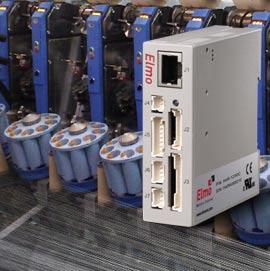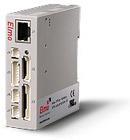Textile- Winding Machine Product Name – Harmonica
Machine Description
The company for which this application solution was developed is one of the largest manufacturers of textile machinery. The company designs and manufactures many different models of textile machines for its customers in both the local and international markets.
The machine is a sophisticated, new generation winding machine that was developed by the company’s engineering team. The motion control process is handled by a series of Elmo’s Harmonica digital drives. Each drive receives hundreds of different velocity profiles from a master control board through a standardized serial CanOpen communication channel. Each main winding machine operates up to 64 dependent winding machines that are equipped with 3.5 Nm DC brushless motors controlled by Elmo’s Harmonica. A high inertia metal cup is attached to the rotor shaft which rotates at high speed according to a pre-defined profile. The machine spins yarn from 9 small cylinders into a large, standard size cylinder. The cylinder’s load is located above the motor cup.
The company designed its own control board that calculates the profiled application velocity and sends high speed velocity commands to the Elmo driver through a CanOpen communication channel. The motor is manufactured locally, and it can reach 8000 rpm under a 175 VDC bus voltage, using only a Hall sensor as feedback for commutation, and a velocity control loop.

The Challenge
- Provide the DC bus voltage in a simplified and cost effective solution.
- The solution must be compact and take up a minimum amount of space.
- There must be programming capabilities within the drive to handle and react to different situations.
- Apply a standardized serial communication channel to send velocity commands to the drive.
- Close the velocity and current control loops inside the drive with high precision, using only digital Hall Effect sensors for commutation and velocity control.
- A high performance, reliable solution is required.
- The drive must be able to handle safety issues automatically.
- Operate under Extreme Environment Conditions (EEC machinery).
- Apply a fast deceleration response with the high load inertia using a special implementation of an electrical brake mechanism (implemented via firmware on the Elmo drive.)
The Elmo Solution
The compact nature of this machine requires compact electronics and a minimal amount of cabling. Drives designed with high power density and for high performance, with fast serial communication channels, are an optimal fit.
The Harmonica digital drives were chosen for this application. The Harmonica drives were selected due to their compact size (82 x 25.4 x 75 mm) and ability to support up to a 200 VDC bus. The velocity control is carried out using only digital Hall Effect sensors. The Harmonica is also capable of operating in extreme industrial environments.
Elmo has chosen to provide its DC based drives for this application solution. This is due to the wide range of DC drives that provide high intelligence and high power combined with compact dimensions. Elmo’s DC solution involves a low-cost isolated transformer and simple continuous power supply with shunt regulation capabilities. Implementation of the DC solution resulted in a compact, reliable, high performance and cost effective total solution.
The size of the drive was one of the key issues in this application, as 64 machines are placed in series in one production line. Widening one machine by even a few centimeters may result in an overall increase of a few meters to the total line, and this can be unacceptable when considering the constraints of the production floor. Another important issue was the performance of the drive in a harsh and extreme environment. The drive is required to operate 24 hours a day in an environment that includes vibrations, dust, humidity, etc.

During the initial stages of the project, the master card controller transmitted an analog velocity command to each drive. The command was decoded by the drive using an internal user program which produced an equivalent velocity command. During the later stages of the project this analog command was replaced by a CanOpen communication channel command. This change significantly enhanced the performance of the machine and did not require any costly mechanical changes. Using the standardized CanOpen communication channel with Elmo’s special implementation of the binary interpreter, simplified the issue of handling the standardized CanOpen protocol. The result was a significant reduction in the software development programming time. The drive’s internal programming ability also enables Elmo to enhance the performance of the machine and increase its safety and reliability by automatically dealing with, and responding to, unexpected situations that arise during the operation of the machine.
Implementation of high level internal control algorithms within the Elmo drive enable high performance capabilities even though only digital Hall sensors serve as the feedback element to the drive’s servo control loop.
A special feature was implemented in the drive. The drive provides a braking mechanism that is implemented by a special control algorithm within its firmware. The electronic brake decelerates the load’s high inertia at a very high deceleration rate and holds it still under a highly controlled torque.
Harmonica Intelligent Digital Servo Drive
Model number and description:
Harmonica based digital drive, 6.6 A cont/13.2 A peak, 40-195 VDC equipped with digital Hall sensor feedback and a CanOpen communication channel.
Why Elmo:
- Elmo’s DC voltage bus-based solution, on this 64 axis machine with DC power, can be more efficient than an AC voltage power solution, saving cables and additional components such as contactors, breakers, etc. In addition, less space is required for the electrical cabinet making it easy to install, and the solution is cost effective.
- Using digital Hall sensors as feedback, it is very hard to reach velocity accuracy. However, with Elmo’s driver and special gain scheduling technology, the customer easily achieved high velocity accuracy. In addition, even though the local motor’s winding capabilities and quality are not optimal, the Elmo driver was able to reach good control performance without any problem.
- As there was a limitation of installation space, the compact size of Elmo’s Harmonica drive made it possible to place it in the machine and save significant amounts of space.
- The solution’s powerful programming capability allowed for the program to be implemented inside the drive and it can be executed without any help from the PLC control board. In addition, the driver also controls its own I/O, reducing the control board’s heavy load.
- The high stability textile machines work in the ultimate extreme environment, with heavy dust, high humidity, vibrations, high temperature and low level operators. The machines also run constantly for 24 hours every day without any stopping. Elmo’s drives can perform very well in such environments with high stability.
- With Elmo’s drive the machine can run at 7200 rpm and still change the velocity profile via CAN communication with very high frequency.
For More Information

